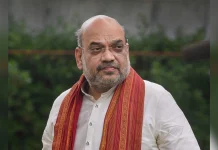As soon as it became clear that the incumbent Bharatiya Janata Party (BJP) was headed for a drubbing in Karnataka, the Internet exploded with gleeful memes. Oddly, though, most of these posts from the usual corners hailed the defeat of ‘evil, fascist, Hindutva’ forces more, and the victory of the Congress less. Many exposed their latent cultural separatism in a map which showed that the BJP had been ‘kicked out’ of south India.
By Venu Gopal Narayanan
An equal number adopted a scientific bent to conclude that Hindutva doesn’t work in the south, while the psephologically-inclined attributed this loss to a Lingayat rejection of a supra-caste ‘Hindu’ identity.
Others took their immature glee a step further to provocatively suggest that the BJP’s defeat heralded the advent of an independent ‘United States of South India’.
If social media, and its exultant echoes in mainstream media, were to be believed, the BJP was stopped in its tracks by the secular ways of the south.
Yet in their joy, very few realised that this ‘secular’ repulsion of the BJP was actually wrested at the political cost of another so-called secular party, the Janata Dal (Secular), the JD(S), whose votes shifted in large numbers to the Congress, and in a lesser degree to the BJP.
This is what forces us to hold to our central thesis: that the BJP lost mainly because the identity vote consolidated under the Congress banner.
In other words, the index of opposition unity went up considerably, most of the contests became more bipolar, and margins became tighter.
Now, it is true that a small-but-crucial portion of the Lingayat vote did abandon the BJP to debilitating effect in the electorally important regions of central and Bombay Karnataka, in spite of the successful state-wide implementation of multiple welfare schemes and development projects.
It is also true that the BJP failed to attract the tribal vote in spite of having resolved a legacy administrative issue of tribal land deeds (their hakku patras).
However, this ‘secularism-of-the-south-stops-BJP’ thesis does not hold up to scrutiny. Instead, the data shows that the contest was messier and keener than most realise.
The negatives first:
One, the BJP’s vote share came down by just -2.4 per cent in Bombay Karnataka. Yet it lost 17 seats to the Congress and one to the JD(S).
There are two reasons for this: the average BJP vote share decline in these 18 seats was -7.4 per cent, which was amplified by a shift of almost 4 per cent of the ‘Others’ vote to the Congress.
Together, this allowed the Congress to surpass the BJP’s healthy win margins of 2018.
However, of the remaining 32 seats in the region, the BJP’s vote share actually went up by an average of 10 per cent in 16 seats. Most of this came from the JD(S) and ‘Others’, and the BJP even made four gains from the Congress.
Two, similarly in Central Karnataka (which has 37 seats by our mapping), the BJP’s vote share reduced by only -2.1 per cent. Yet it still lost 15 seats to the Congress with an average vote erosion of 10 per cent in these seats.
This was facilitated by a shift of over 8 per cent votes from the JD(S) to the Congress.
Yet in the balance 22 seats, the BJP’s vote share went up by 3 per cent (over 15 per cent in five seats), and it even managed to gain 105-Harihar from the Congress.
Three, although the BJP lost 3.1 per cent vote share in Coastal Karnataka, it still swept the region because of its high vote base.
Four, on paper, the BJP’s vote share in Hyderabad Karnataka went down by -3.5 per cent, and it lost 10 seats to the Congress. But this is also the region where the BJP made some remarkable gains: it won six seats from the Congress and one from the JD(S), and its vote share went up in 18 seats. Two of these gains were secular firewall seats which the BJP had never won since the delimitation of 2008.
Five, in the 36 seats reserved for Scheduled Castes (SCs), the BJP’s vote share went down by -2.1 per cent, and its seat tally declined from 16 to 12. But this included four gains and a rise in its average vote share by 7 per cent in 15 seats.
Unfortunately, this was overshadowed by the Congress’s 13 gains on the back of a 3 per cent vote shift from the JD(S).
Six, the BJP was wiped out in all the 15 seats reserved for Scheduled Tribes (STs). It lost the six seats it had, and 5.1 per cent of its vote share shifted to the Congress.
The BJP’s tribal talisman, B Sriramulu, lost from Bellary by a painful margin of 16 per cent.
Frankly, a wipe-out of this magnitude is inexplicable, save to note that there was a clear consolidation of tribal votes under the Congress. The best one may offer by way of interpretation, is that the promise of freebies clicked here.
Seven, The BJP’s vote share went down in 119 seats by a total of -7.1 per cent. Around 2 per cent went to ‘Others’, a little less to the JD(S), and 4 per cent to the Congress.
But the impact of this shift is not straightforward, since the Congress too, lost votes in 24 of these 119 seats, the BJP held 14 seats, and 16 were messy three-way fights.
On the other hand, eight, the BJP’s vote share went up in 105 seats by a total of 9.4 per cent.
In 60 of these seats, the positive vote swing was more than 5 per cent, and the BJP made 21 gains with 23 holds.
The Congress, on the other hand, made only 6 gains from the BJP in these 105 seats, and that too, only because they pulled votes from the JD(S).
Nine, the BJP improved its position in the Bengaluru region strongly, winning more seats and votes.
Its vote share went up by over 6 per cent in this region, and it also won an important secular firewall seat handsomely – 156-Mahalaxmi Layout.
Ten, similarly, the BJP’s standing in Southern Karnataka rose by 2.5 per cent.
While it did lose nine seats it had previously held, on account of a consolidation of the identity vote under the Congress, the BJP still managed to gain three seats from the JD(S) in the latter’s bastion, including the politically significant reserved SC seat of Sakleshpur.
Thus, it would be technically incorrect to look at the results superficially and conclude that the shift in mandate was the result of any secularist ideology.
The above data also makes it difficult to prove that anti-incumbency was a driving force behind the BJP’s loss.
Instead, what emerges is a patchwork quilt of multiple factors at play simultaneously, ranging from some turbulence in the BJP’s Lingayat vote base to the disintegration of the JD(S) and a shift of its votes to the Congress.
Even as the BJP lost votes in half the seats, it gained in the other half. And if it had managed to hold on to just 2 per cent of its core vote base, the results would have been quite different.
So, rather than crowing that secularism won, analysts of that feather should realise instead, that the verdict was a mixture of identity politics, rumblings within the BJP, the allure of reckless welfarism, and sheer luck.
And the truth is that the very identity politics that was successful in dislodging the BJP will ensure its return to the Vidhana Soudha in due course. Secularism is not sustainable; only development is.
All data from Election Commission of India website.
This article first appeared in www.swarajyamag.com and it belongs to them.







